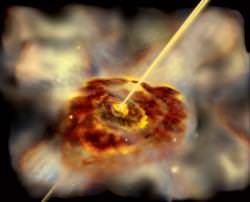There’s a book by Larry Niven called “Hole Man”, where a group of explorers on Mars come across an alien communications device. One of the scientists thinks there’s a microscopic black hole inside, which powers the device, and to prove it, he turns off the containment field. The black hole falls into Mars, consuming the planet from within, and threatening the entire solar system.
Just science fiction? Maybe not. According to B.E. Zhilyaev, a researcher at the Main Astronomical Observatory in Ukraine, in the research paper Singular Sources of Energy in Stars and Planets, the Universe could be buzzing with these microscopic blackholes. They might even be inside stars and planets.
This isn’t a new concept. Physicists have been theorizing about the possibility of microscopic, primordial black holes for years, and used them to explain everything from dark matter to gamma ray bursts.
It takes a star several times the mass of our Sun to form a black hole naturally when it dies, so there probably isn’t a process that can make them any more. But during the first few moments after the Big Bang, the entire Universe was compressed into a microscopic singularity. These primordial black holes could have been generated right at the beginning, and have been with us ever since.
It’s also theorized that the new Large Hadron Collider might be capable of creating microscopic black holes through the collision of particles at relativistic velocities.
Before you can wrap your head around this research, consider how big a black hole has to be. For a stellar mass black hole, the event horizon – the point at which nothing can escape – is only a few kilometres from its centre. A black hole with the mass of the Earth? It would be less than 2 cm across. A black hole with the mass of a mountain? Smaller than a hydrogen atom.
Even though a microscopic black hole might contain the mass of a mountain, it would experience almost no friction as it passed through regular matter. It would fall through regular material as if it wasn’t there.
In most encounters with stars, these black holes would pass right through. But in a three-body interaction, between a star and a planet for example, the black hole could be trapped inside the star. The black hole would then orbit inside the star for billions of years until it comes to rest at the centre. They could form with the stars and planets from a protostellar cloud of gas and dust, or be captured and incorporated later.
So how do you know if you’ve got a black hole in your star? As the black hole grows over time, it starts to change the amount of heat generated by the star. A large enough black hole could cause the star to expand in size, and even undergo a supernova prematurely. According to Zhilyaev the interactions between stars and microscopic black holes could be detectable through bursts of gamma rays.
And if a black hole gets inside your planet? You get additional heat. This might account for unusual temperatures seen on Saturn and Jupiter, which are hotter than they should be from solar heating alone. A black hole inside the Earth might actually raise temperatures on the surface enough to sustain animal life long after the Sun dies out.
A power source that would last for eons, providing the most efficient possible conversion of matter to energy. Just don’t think about the monster consuming the ground beneath your feet as it keeps you warm.


thats new to me.. so, may the bermuda triangle be a microscopic black hole?
Wow. That’s a frightful thought.
“consuming the ground beneath your feet”
After the sun dies out all of the plants will die and most of the animals would die because there would be no plants
can a man generated a black hole.
plz give me reply on [email protected]
[email protected]
Don’t forget Riofrio’s black holes hiding in the centers of the planets and moons of the solar system. To get around the Hawking radiation problem either the BH must be large or light must slow with time.
look guys I’m not into Astro physics but I just want to know if it’s possible for a black hole or a worm hole be behind the mystery of the bermuda tiangle
I don’t believe in this theory. Tell me when u actually find a block hole inside our planet. I believe it is possible for there to be microscopic black hole but they are probably super rare and don’t cause gravity in planets or stars.
How long would the black hole take to grow? If a microscopic black hole feel into the center of our planet and could only reach a few surrounding atoms, then it wouldn’t expand all that much, right?
Or is this all hypothetical with no way to possibly guess at?